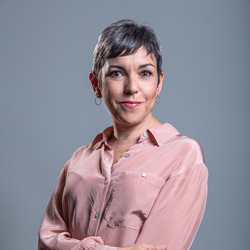Pampa Molina
4. Kaleidoscope
Science journalism never sleeps

Pampa Molina, coordinator and editor-in-chief of Agencia SINC and coordinator of Science Media Centre Spain
In the last two years, we were steamrolled by a pandemic that has left us reeling. Correction: we are still going through it, and, for now, we do not know when it will end. Nor do we know for sure when we will be able to stop talking about Covid-19 as a serious public health issue. In the media, we come across terms such as gripalización (literally, ‘flu-ization’, i.e. shifting to an endemic, rather than pandemic, approach to Covid), which only muddy the waters further, as if the flu did not claim thousands of lives every year, as if Spain did not have teams specialized in tracking the influenza virus strains we can expect each year and monitoring their incidence, health sentinels that work in a network to minimize the harm to the population.
For science journalists, these have been (and still are) the best and worst years of our professional lives.
Let’s start with the bad part. We have been working tirelessly since March 2020 (actually, since before then) to provide urgent and reliable answers to a population that desperately needed them about the biggest public health crisis we have ever experienced. We had to search for these answers rigorously, calmly and thoughtfully, when we ourselves, like everyone else, were also afraid and needed to disconnect from the information overload that the pandemic ushered in in order to reconnect with other parts of life. Only we couldn’t, because our job consisted precisely of handling the avalanches of information, filtering them to select only the relevant parts, watching out for any misinformation being spread in order to debunk it; in short, our job was to deliver clear, easily understandable messages to a frightened and vulnerable population.
The effects of the first months of the pandemic on the mental health of professionals in our field have been studied. In a 2020 paper, Nereida Bueno and Rocío Rodríguez Rey, of the Pontifical University of Comillas, found that 48.6% of communication professionals reported having experienced a severe psychological impact, and 60% reported overworking during the crisis.
And now, for the good part. We have demonstrated that we are essential. Traditionally, we were the ones who wrote about dinosaurs and supernovas, the Higgs boson and listeria outbreaks, and, sure, every once and a while, we were hastily sought out to explain what was happening at a nuclear power plant meltdown or a WHO report on the link between cancer and red meat. Since 2020, things have changed. The media now understand that science journalism is not popular science; it is daily reporting on current affairs related to politics, the economy and public opinion.
We have experienced the responsibility and satisfaction that comes with this shift intensely at the agency I head, SINC, which has witnessed an unprecedented boom. In March 2020, the European Parliament’s European Science-Media Hub selected us internationally as a ‘reliable source of information about Covid-19’. In the first months of the pandemic, our audience swelled by 110%, a figured that has since levelled off and today remains 75% higher than in 2019; and in July 2021, we became the Spanish node of the Covid-19 Vaccine Media Hub, an international project providing truthful information about Covid vaccines to journalists.
The Covid-19 information storm has subsided, but science is in the news every day: hepatitis of unknown origin in children, scientific diplomacy in Russia, a salmonella outbreak linked to Kinder eggs... We continue to keep pace with the news as it breaks due to the great public demand that has been created for reliable information about science.
The Covid-19 information storm has subsided, but science is in the news every day: hepatitis of unknown origin in children, scientific diplomacy in Russia, a salmonella outbreak linked to Kinder eggs... We continue to keep pace with the news as it breaks due to the great public demand that has been created for reliable information about science.
We see it as a moment of opportunity. Which is why, for the last year, we have been working on a new project, which we launched on 25 March in Madrid: the Science Media Centre Spain, an independent information office providing resources for the research community, communication directors and journalists to cover the news when science makes the headlines. Part of an international network with eight other members from different countries, we are the first of our kind in Spanish and the third in all of Europe.
But if we were already too overwhelmed with work to find a moment’s rest, why did we get ourselves into this new mess? Well, because we think it makes sense to seize this opportunity to grow science journalism in our country, a profession that has proved essential as a creator of public service information.
